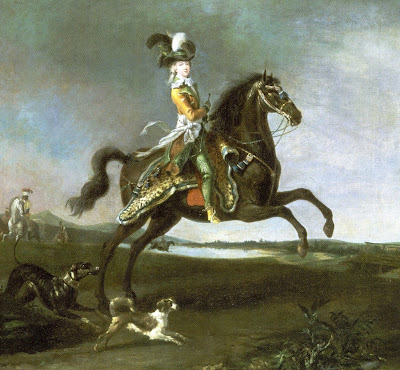 Louise-Auguste Brun, Marie Antoinette on Horseback (1781-82)
Louise-Auguste Brun, Marie Antoinette on Horseback (1781-82)Reunion des Musees Nationaux
Although much is made of Marie Antoinette's choices of gowns, hairstyles and accessories, one of the Dauphine's most rebellious fashion choices is rarely written about. After learning to ride in order to accompany her husband and grandfather on the hunt, she abandoned the long flowing skirts of a sidesaddle rider and adopted slim breeches as part of her equestrienne habit.
Women often wore breeches for riding, but they were typically covered with petticoats and skirts. Fashion dictates at the time disapproved of breeches because they allowed women to "assume the poses and gestures of men". At the time, it was believed that straddling a horse threatened a women's reproductive organs.
Her mother, the Empress Maria Theresa, begged her to give it up:
"Riding spoils the complexion, and in the end your waistline will suffer from it and begin to show more noticeably. Furthermore, if you are riding like a man, dressed as a man, as I suspect you are, I have to tell you that I find it dangerous as well as bad for bearing children -- and that is what you have been called upon to do; that will be the measure of your success."
In 1771, Marie Antoinette commissioned her portrait of herself in a masculine-style riding outfit by Josef Krantzinger. While this painting has been lost, it is believed that the artist captured "her joy so effectively that even her mother was mollified when she saw the painting, declaring it one of the most true-to-life images she had yet seen of her daughter" (Queen of Fashion, Caroline Weber, Picador Press, 2005, page 87).
In the painting of Marie Antoinette on horseback shown above by Swiss-born court painter Louise-Auguste Brun, she is dressed in the blue habit of the hunt at Versailles. She rides her horse astride and her horse is drawn up into a bold rearing stance, in bold imitation of the heroic and mythologizing equestrian depictions of the Sun King, Louis XIV.
Marie Antoinette's defiance of traditional riding garb did not harm her reputation at this point in time (although it would later haunt her as "proof" of her lesbianism and insatiable thirst for power). People were tired of the excesses of the King's favourite, Madame DuBarry, and the abuses of the ruling caste.
Parisians were enchanted by the young Dauphine and around 200,000 people turned out to catch a glimpse of her on a procession through the city in June 1773. Perhaps they hoped Marie Antoinette would lead them into a new age like the another French cross-dressing equestrienne, Joan of Arc.